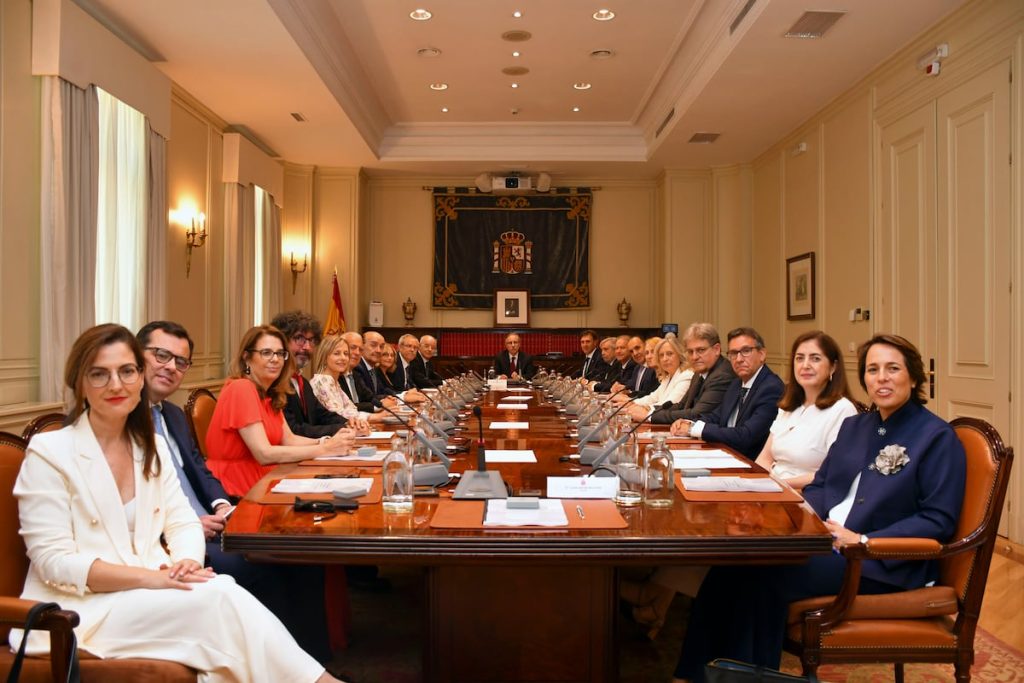The 20 members of the General Council of the Judiciary (CGPJ) have not been able to reach the necessary consensus to elect the president of the institution two days before the opening of the judicial year, which will take place next Thursday under the presidency of King Felipe VI. The only agreement reached yesterday was to open up the existing candidacies to other names, which does not guarantee a final agreement. There have been several contacts and meetings on Monday – including a plenary session in the afternoon – without any progress in the negotiations. The conservative bloc maintains its radical opposition to the three female judges proposed by the progressive group as candidates for the presidency of the Council, which also includes the presidency of the Supreme Court, placing its holder among the highest authorities of the State. Sources familiar with the votes explain that the session ended in a tie with 10 votes each for Judge Ana Ferrer and Judge Carmen Lamela. Both sectors of the institution agree that the lack of agreement leads to a “dramatic” situation as the expectations of opening a new dynamic in the leadership of the Judiciary have so far been frustrated, following its renewal by an agreement between the PSOE and the PP last July.
This agreement on the seriousness of the situation is the only thing they agree on, as disagreements arise when it comes to determining the responsibilities for not reaching an agreement, preventing the body from effectively getting to work, paralyzed by the lack of consensus on its presidency. Both groups regret that this lack of progress in their new phase is becoming more visible on the eve of the start of the judicial year, in which the right-wing judiciary sees as mere difficulties in understanding and the progressive vocalists describe as blocking maneuvers by the former. Conservative group members propose Judge Pablo Lucas to preside over the Council as they consider him the ideal representative of the progressive sector of the judiciary, although on Monday they supported Lamela following demands from progressives that a woman should lead the institution. The left-wing judicial vocalists, on the other hand, maintain their three candidates, Pilar Teso, Ana Ferrer, and Ángeles Huet, considering that for the first time in history it is time to choose a female judge to head the Judiciary.
Conservatives cling to the argument that they “do not feel represented” by any of these three female judges to reject the proposal to elect one of them from the Supreme Court. This attempt to justify what they consider a mere blocking exercise has outraged members of the progressive sector of the judiciary, who resist accepting the conservatives’ vetoes. This resistance to accepting the impositions of the judicial right is based on the belief that the conservative sector is blatantly violating part of the procedural agreements that allowed the renewal of the Council of the Judiciary, although it is now seen as incomplete. This pact meant that the conservative group would choose from the candidates proposed by the progressives. In this way, it could be understood that the presidency of the Council and the Supreme Court was the result of the initiative of the progressives, but through a shortlist for the conservatives to choose one of their members.
Progressive vocalists add more arguments they consider compelling for conservatives to accept one of the three Supreme Court judges they have proposed for the position. Two of them – Pilar Teso and Ángeles Huet – belong to the Contentious Chamber and Ana Ferrer to the Criminal Chamber, and all three have extensive experience in the judiciary. For progressives, it is incomprehensible that conservatives veto these proposals as a whole and insist that they should decide which candidate from the left-wing judiciary is the most representative. The sources consulted emphasize that progressives have not made such demands in similar previous situations. Traditionally, conservatives have historically imposed their majority in the Council when they have had it, and have used it to elect a president of the same ideological orientation, while now breaking a pact that was part of the basic consensus for the different stages of the institution.
Furthermore, the same sources note that in the recent agreement to unblock situations, no veto was used in the case of appointing a Constitutional judge to replace Alfredo Montoya, from the conservative sector. These sources emphasize that progressives accepted the proposal to appoint José María Macías to the position without asking conservatives to present a shortlist or later change to a fourth candidate not part of the proposing group’s initiative.















